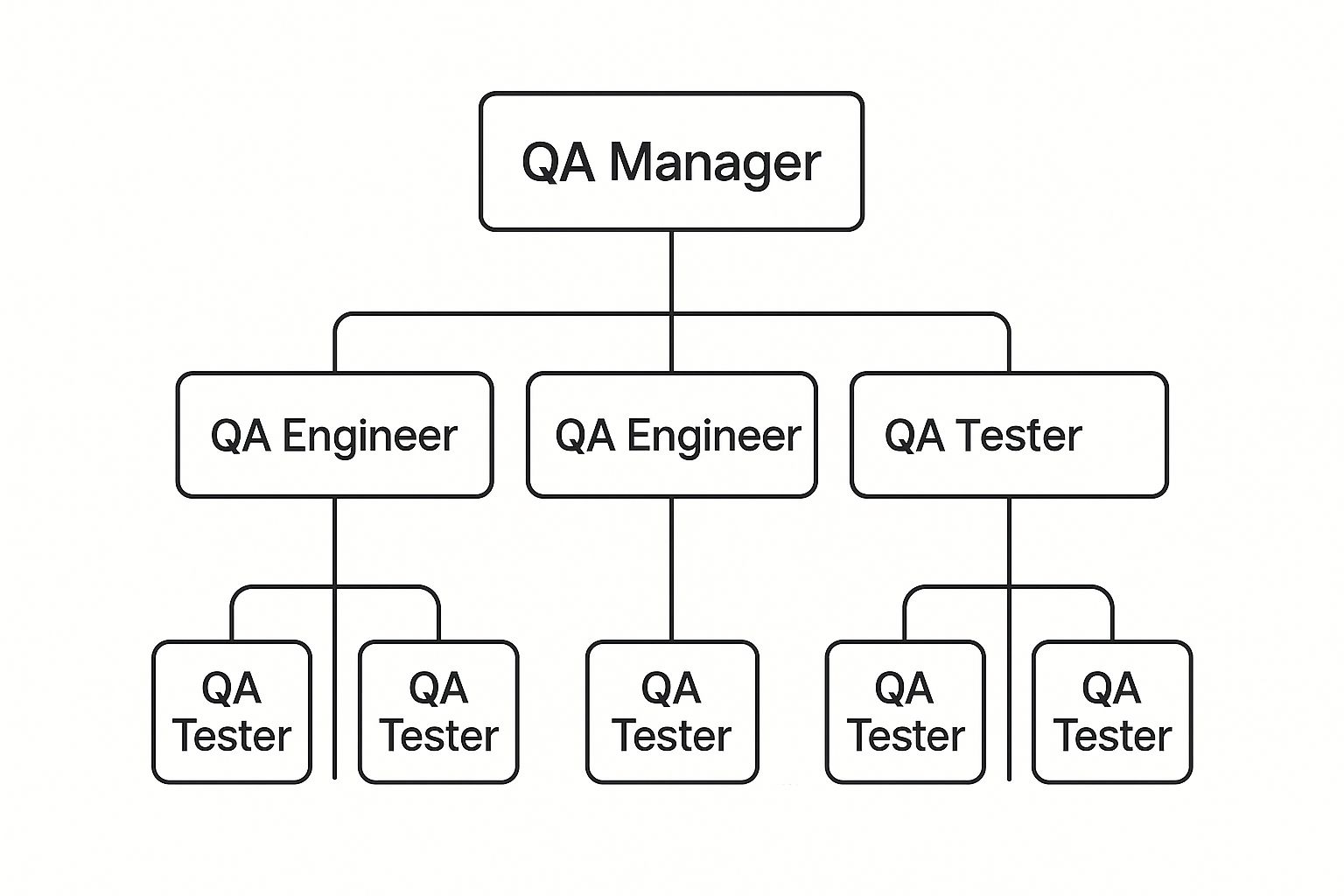A Guide to QA Team Roles and Responsibilities
- Ron Smith

- Jul 20
- 13 min read
When we talk about qa team roles and responsibilities, we’re not just talking about a group that hunts for bugs at the end of the line. That’s an old-school, assembly-line way of thinking. A modern QA team is woven directly into the fabric of product development from day one, acting as a constant partner in quality.
They're involved in everything from the user experience a customer feels to the raw stability of the system under the hood.
What Does a Modern QA Team Actually Do?
Stop thinking of a QA team as an isolated department that just ticks boxes and files bug reports. Picture them more like the mission control crew for a rocket launch. Every single person has a critical job, and if they don't work together flawlessly, the whole mission is at risk. This team is the architect, the navigator, and the safety inspector for your product’s entire journey.
Their real job is to embed a quality-first mindset into the entire software development lifecycle. It’s a proactive game of preventing defects before they even get written into code, not just reacting to them later. This requires a deep, almost intuitive understanding of what users want, what the business needs, and what the technology can handle.
A modern QA team's value is measured not by the number of bugs it finds, but by the number of bugs it prevents from ever being created. This shift from detection to prevention is a fundamental change in how high-performing organizations view quality.
Core Functions of a QA Pod
To get that comprehensive coverage, a tight-knit QA "pod" or unit will typically zero in on a few key areas. These functions aren’t just a checklist; they’re distributed across different roles to create a balanced, effective quality machine.
Here's what that looks like on the ground:
Strategic Planning: This is the big-picture thinking. It involves mapping out the entire testing strategy, choosing the right tools for the job, and making sure the QA team’s efforts are perfectly aligned with project deadlines and business goals.
Manual and Exploratory Testing: You can't automate human curiosity. This is where testers use their intuition to explore the application like a real user would, uncovering weird edge cases and frustrating usability issues that a script would fly right past.
Automation and Efficiency: For all the repetitive but necessary checks, automation is king. This group builds and maintains a suite of automated test scripts that run constantly, freeing up the human testers to focus on the tricky, high-impact stuff.
Risk Assessment: This goes way beyond just finding bugs. A modern QA team is constantly identifying potential threats to the product’s quality, stability, and security. They play a huge part in broader [SaaS risk management](https://saasoperations.com/saas-risk-management/), acting as the first line of defense against anything that could destabilize the product or expose the business.
To help you visualize how these pieces fit together, here's a quick summary of the core roles you'll find in a well-oiled QA team.
Core QA Team Roles at a Glance
Role | Primary Function | Key Focus Area |
|---|---|---|
QA Manager/Lead | Provides strategic direction and oversight. | Team leadership, process improvement, and aligning QA with business goals. |
QA Automation Engineer | Builds and maintains automated testing frameworks. | Efficiency, scalability, and reducing manual testing effort. |
Manual QA Tester | Executes test cases and performs exploratory testing. | User experience, usability, and finding complex, real-world defects. |
Performance Engineer | Focuses on the application's speed, stability, and scalability. | Load testing, stress testing, and identifying performance bottlenecks. |
Each role is a specialty, but they all work toward the same goal: shipping a rock-solid product that customers love.
The infographic below illustrates a common structure, where managers guide the overall strategy, engineers build the tools and automation to make it happen, and testers are on the front lines executing the plan.

This kind of structure creates clear lines of communication and makes everyone accountable. It allows for both high-level strategic guidance and the detailed, hands-on testing that’s needed to catch every last issue.
The Strategic Vision of QA Managers and Leads

If you think of a QA team as mission control for a product launch, the QA Manager and QA Lead are the flight directors. They're the ones who provide the leadership that turns quality from a checkbox exercise into a real strategic advantage.
While their titles sound similar, their roles are distinct. Together, they form a powerful dual-leadership structure that gets things done. It’s a common source of confusion, but understanding the difference is key to building a high-performing team.
The QA Manager is the strategist—the architect of the entire quality vision. They operate at the 30,000-foot view, focusing on the "why" and "how" of quality assurance. Their job is to align the QA department's work with the company's bigger goals, secure the right budget, and choose the technologies that will keep the testing process relevant for years to come.
They're constantly asking the big-picture questions: Are our testing efforts actually reducing business risk? Are we investing in the right kind of automation? How does our quality directly impact customer retention and the bottom line? This strategic oversight is what makes a QA department a business asset, not just a cost center.
The Tactical Field Commander
While the manager sets the strategy, the QA Lead is the tactical commander on the ground. They are deep in the trenches, working side-by-side with testers and developers to make sure projects stay on track and the vision becomes reality.
Their role is a potent mix of technical know-how and team mentorship. A QA Lead assigns tasks, mentors junior testers, and serves as the critical communication hub between the QA team and everyone else—developers, product owners, you name it. This direct involvement is what keeps project deadlines from slipping and resources from being wasted.
A QA Lead ensures the team is doing things right, while a QA Manager ensures the team is doing the right things. This distinction is the secret to building a quality process that is both efficient and effective.
Bridging Strategy and Execution
This dual-leadership model is what connects high-level strategy to concrete, daily actions. It’s not just theory; it’s practical. For instance, teams looking to improve their output need to optimize Jira resource management for better team performance—a perfect example of a lead turning a manager's goal for efficiency into a specific, actionable workflow improvement. This synergy is especially critical in fast-paced agile environments where speed and quality can't be compromised.
This partnership is also where emerging trends in workforce management, like contingent labor and new kinds of staff augmentation, really shine. A manager might identify a strategic skills gap—say, a sudden need for specialized performance engineers for a major launch. The lead is then responsible for integrating that new global talent seamlessly into the team's daily workflow, without missing a beat.
To see how specialized roles like this fit into the bigger picture, our guide on mastering DevOps team roles and responsibilities offers a deeper look at how modern tech teams are structured for success.
Ultimately, this collaboration between manager and lead transforms quality from a final gate before release into a core principle that guides the entire development process from start to finish.
The Human Element: Why QA Analysts and Testers Still Reign Supreme

Sure, automation is fantastic for handling repetitive, predictable tasks. But when it comes to true quality, the heart and soul of the process is—and always will be—human. QA Analysts and Manual Testers are the last line of defense for your end-user. They bring a level of intuition, curiosity, and creativity that no automated script can ever hope to match.
Their job isn't just about finding bugs; it's about charting the entire user journey.
Think of them as product detectives. An automated script can tell you if a button works. A human tester, on the other hand, can tell you that the button feels awkwardly placed, that the workflow is confusing, or that the whole experience is just plain frustrating. They approach the application with genuine empathy, intentionally trying to get lost or break things in the same weird ways a real, non-technical user would. This is how you uncover the kind of edge cases that kill user satisfaction.
Their real magic lies in translating a technical glitch into its real-world business impact. A QA Analyst can see a "minor" bug and immediately articulate how it will lead to abandoned carts, negative reviews, and a damaged brand. That perspective is what helps you prioritize what actually matters.
The Undeniable Power of Manual and Exploratory Testing
In an industry obsessed with speed, it’s tempting to think manual testing is obsolete. It’s not. In fact, it's more critical than ever, especially when it comes to exploratory testing. This is an unscripted, freestyle process where the tester learns, investigates, and probes the software all at once. It’s pure, focused curiosity.
Manual and exploratory testing aren’t about finding what's broken. They're about discovering what's frustrating, confusing, or just unenjoyable for the person on the other side of the screen. It's the gap between a product that works and a product people love.
This hands-on approach is the foundation of any solid quality strategy. While automation delivers speed, manual testing provides depth and context. It’s how you assess true usability and catch those bizarre issues that only human critical thinking can spot.
Building a Team with the Right Human Skills
A killer QA team needs more than just technical chops. You need people with razor-sharp analytical skills, an obsessive attention to detail, and a deep-seated empathy for the user. These aren't just testers; they are advocates.
For those looking to specialize, particularly in reviewing documentation or user-facing content, developing quality assurance editor mastery provides a massive competitive edge.
Ultimately, these human-centric roles ensure your final product is more than just a bundle of working features. They guarantee it's a cohesive, intuitive, and genuinely enjoyable experience. This philosophy is a cornerstone of any modern agile team structure, where quality isn’t just a department—it’s a shared mission.
Driving Efficiency with Automation and Performance Engineers
While your QA analysts and manual testers are busy protecting the user experience with their intuition and sharp eyes, another group of specialists is working behind the scenes. These are the technical heavyweights of the QA world: the Automation and Performance Engineers. They're the ones who inject speed, scale, and raw resilience into your testing process.
Think of them as the builders and the stress-testers. They make sure your software isn’t just functional—it’s fast, stable, and ready to handle whatever the real world throws at it.
A QA Automation Engineer is basically the architect of a digital testing workforce. Their whole job is to build and maintain a suite of automated tests that can run 24/7 without getting tired. Instead of a human clicking through the same checkout flow for the thousandth time, they write code that does it automatically. This frees up your manual testers to do what they do best: creative, complex, and exploratory testing.
The point of automation isn't to fire your manual testers. It’s to superpower them. By taking over the repetitive, soul-crushing checks, automation engineers let the team cover way more ground in a fraction of the time.
This role is the engine that drives modern Continuous Integration and Continuous Deployment (CI/CD). With solid automation in place, you can test every single piece of new code the second it's committed. That means you catch bugs almost instantly, not weeks later. This is how smart companies release better software, faster.
The Rise of the Hybrid Automation Engineer
The job of a QA Automation Engineer has changed—a lot. It’s no longer enough to just know your way around a testing tool. Today, these engineers are expected to be full-blown developers.
They need to be fluent in languages like Python, Java, or JavaScript and be masters of frameworks like Selenium or Cypress. They also have to understand CI/CD pipelines inside and out to build tests that don't break every other day. It’s a hybrid role, demanding a mix of coding chops, testing instincts, and a strategic mind. For a deeper look at how these roles have shifted, you can explore this full analysis of modern QA roles.
Ensuring Stability Under Pressure with Performance Engineers
So, if automation engineers handle functional correctness, Performance Engineers are all about strength and stability. Their entire focus is on answering the tough questions:
Can our app handle 10,000 users logging in at once for a Black Friday sale?
What happens to our response times when a marketing campaign sends a massive traffic spike our way?
Where are the hidden bottlenecks that will bring our system to its knees right when it matters most?
These specialists use load and stress testing tools to simulate real-world chaos, pushing the application to its absolute breaking point to see what gives. They find the weaknesses before your customers do.
Their work is what prevents those dreaded outages, keeps the user experience snappy, and proves your application is ready to scale. This is exactly the kind of specialized skill companies can tap into through newer talent models, accessing world-class engineers on-demand to prep for a huge product launch without the overhead of a full-time hire.
The Future of QA and Building a Global Team

The ground is shifting in quality assurance. The old rulebook on how to build a QA team is being completely rewritten by emerging trends in technology and workforce management. If you’re still thinking about QA team roles and responsibilities in the traditional sense, you’re already falling behind.
Two massive forces are driving this shift: the practical rise of AI and the strategic move toward global, contingent workforces. Artificial intelligence isn't some far-off concept anymore; it's a real tool in the QA arsenal. We're seeing AI advancements handle tasks that used to be painstakingly manual, from generating smart test cases to predicting where bugs are most likely to hide in the code.
This tech evolution is also changing the very definition of a QA pro. The market is screaming for what we call ‘T-shaped’ professionals. These are the people with deep, specialized expertise in one core area—like test automation—but who also have a broad understanding of other domains like data analysis, development, and business strategy.
The New Shape of QA Talent
This pivot to T-shaped skills means QA is breaking out of its silo. It’s no longer just a bug-hunting department; it's a multidisciplinary field that contributes to the product's success from a much wider vantage point.
A few key trends are defining this new reality:
AI-Powered Test Generation: Tools can now analyze an application and spit out relevant test scenarios on their own, cutting down manual work and boosting coverage.
Predictive Defect Analysis: By digging into historical data, AI can flag which parts of your code are high-risk for defects. This allows you to focus your testing where it will actually make a difference.
Data-Driven Quality Decisions: QA pros are now expected to use hard data to back up their strategies, drawing a straight line from quality metrics to business goals.
The best QA teams of tomorrow won't be the ones with the most testers. They'll be the ones who expertly blend human intuition with intelligent automation and data-backed insights. That synergy is the new gold standard.
This evolution fits hand-in-glove with modern development. You can see these principles in action in our guide to agile software development best practices for 2025, where speed and responsive quality are everything.
Building a Modern Global Team Affordably
So, where do you find people with these advanced skills? The old model of hiring full-time, in-office employees is often too slow and expensive to keep up. This is where a new kind of staff augmentation flips the script, offering a faster, more affordable way to build your team with global talent.
This model lets you tap into a global talent pool, bringing on specialized, on-demand QA professionals without the crushing overhead of traditional hiring. Think of it as a contingent workforce built for the speed of tech.
Imagine you need a performance engineer who knows a specific cloud platform inside and out, but only for a three-month project. Instead of a grueling, expensive hiring cycle, you can bring in a vetted expert almost overnight. This gives you the ultimate flexibility to scale your QA power up or down as your projects demand. By tapping into a global, on-demand workforce, you're not just saving money—you're building a more powerful and resilient quality engine for your business.
Common Questions About QA Team Responsibilities
As you start putting your QA strategy on paper, the practical questions always surface. It’s one thing to have a vision for quality, but it's another to figure out the day-to-day details of your QA team roles and responsibilities. Getting these answers right is what separates a team that just runs tests from one that actually drives quality.
Let's dive into the questions that come up time and time again.
What Is the Ideal Ratio of QA Engineers to Developers?
This is the classic question, and the honest answer is: there's no magic number. You'll hear people throw around a ratio of one QA engineer for every 3-5 developers, and sure, that's a decent starting point for many Agile teams.
But don't get hung up on it. The right balance hinges entirely on your reality. How complex is your product? How mature is your test automation? What's your company's actual appetite for risk? The real goal isn't hitting some arbitrary headcount ratio; it's creating seamless collaboration and making sure you have effective coverage.
How Can a Small Startup Handle QA Without a Dedicated Team?
When you're an early-stage startup, every dollar counts, and a dedicated QA team might feel like a luxury. The good news is, it doesn't have to be a blocker. Quality can—and should—become a shared responsibility.
When structured correctly, a "whole team" approach works surprisingly well.
Peer-Testing: Get developers to put another set of eyes on each other's code before it ever gets merged. This catches an incredible amount of low-hanging fruit.
Product Manager Involvement: Your PMs are the voice of the user. Have them own user acceptance testing (UAT) to confirm the product actually solves the problem it's supposed to.
Contingent Talent: What about specialized needs, like a critical security audit before a big launch? You don't need a full-time hire. Modern workforce models let you tap into expert contingent talent on-demand, giving you world-class skills without the long-term overhead.
The trick is to formalize it. You need a simple bug-tracking system and dedicated time blocked out for testing before every single release.
For a startup, the most important thing is to bake quality into your culture from day one. It's not about having a department; it's about building the right habits from the beginning.
What Is the First Step to Introducing Test Automation?
Jumping headfirst into automation is a recipe for disaster. Don't try to automate everything at once—you'll burn out your team and your budget.
Start small. Think smart.
Look for your most critical, mind-numbingly repetitive, and time-sucking manual tests. These are almost always your core user journeys: the login flow, the new user registration, the main checkout process. Automate these "happy path" scenarios first.
Why? Because it delivers the biggest and most immediate win. That early success builds confidence, gets the team comfortable with the tools, and creates the momentum you need to tackle more complex automation down the road.
As technology and workforce management evolve, building your team requires a new approach. Shorepod offers a new kind of staff augmentation, giving you on-demand access to vetted, global tech talent at the most affordable cost. Manage your international team—from interviewing to payroll—all on one platform. Discover a better way to build your team at Shorepod.
Comments